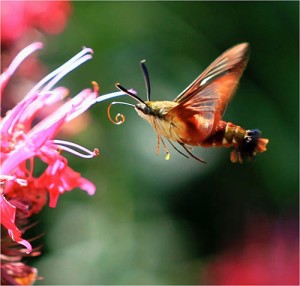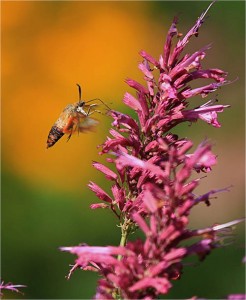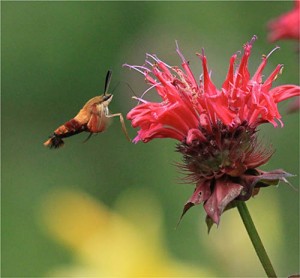It’s Not a Baby Hummingbird – But What is It?

Leslie Abram, Guest Blogger
This blog was written by guest blogger Leslie Abram.
Who Are You?
I admit it. The first time a Hummingbird Moth buzzed past me in my garden, I thought it was a baby hummingbird. I watched closely, trying to follow this speedy little creature as it hovered and zoomed between flowers. I noticed its long curved proboscis curling in and out as it collected nectar from our flowers, and I realized it must be some kind of butterfly or moth.
Meet the Hummingbird Clearwing Moth
Sure enough, these little moths are considered hummingbird mimics, and act in many of the same ways that hummingbirds do. However, their life cycle is completely different, as they are moths, not birds!
In the fall, the caterpillars burrow into the soil to spend the winter as a brown, hard shelled pupae. As spring days grow warmer, they emerge as adult moths. The moths lay their little green eggs on the underside of leaves. These eggs will hatch in about a week, and take about four weeks to become full sized caterpillars. In Canada, the moths usually only go through one breeding cycle per year.
Invite Hummingbird Moths to Your Garden
It’s easy! Two very hardy, long-blooming and beautiful flowers are absolute favourites of these beauties. Plant some Red Bee Balm and Mexican Hyssop, sit back, and enjoy the show![one_third]

Curly proboscis used to collect nectar
[/one_third] [one_third]

Enjoying some Mexican Hyssop
[/one_third] [one_third_last]

Hummingbird Moths love Bee Balm
[/one_third_last]



